Accounting Theory: Fair Value Accounting and its Implications
VerifiedAdded on 2022/11/13
|7
|1736
|262
Report
AI Summary
This term paper delves into the fundamental concepts of accounting theory, primarily focusing on the debate between historical cost and fair value accounting. It begins by identifying the core issue with historical cost accounting, which is its lack of relevancy over time, and then moves on to address 'accounts must reflect economic reality' as a core principle of measurement in accounting, emphasizing the importance of reliable financial statements for stakeholders' decision-making. The paper also explores how economic reality is measured, considering situations that can hinder its achievement, such as rigid accounting principles. The paper then discusses accounting reliability, highlighting its key characteristics: verifiability, neutrality, and faithful representation. The paper concludes by examining the impact of fair values on the roles and functions of auditors, emphasizing the need for auditors to assess the procedures and assumptions used in fair value measurements, and its effect on the training of accounting students and the scope of GAAP's historical cost valuation versus IFRS' fair cost valuation. The report references several sources to support its arguments.
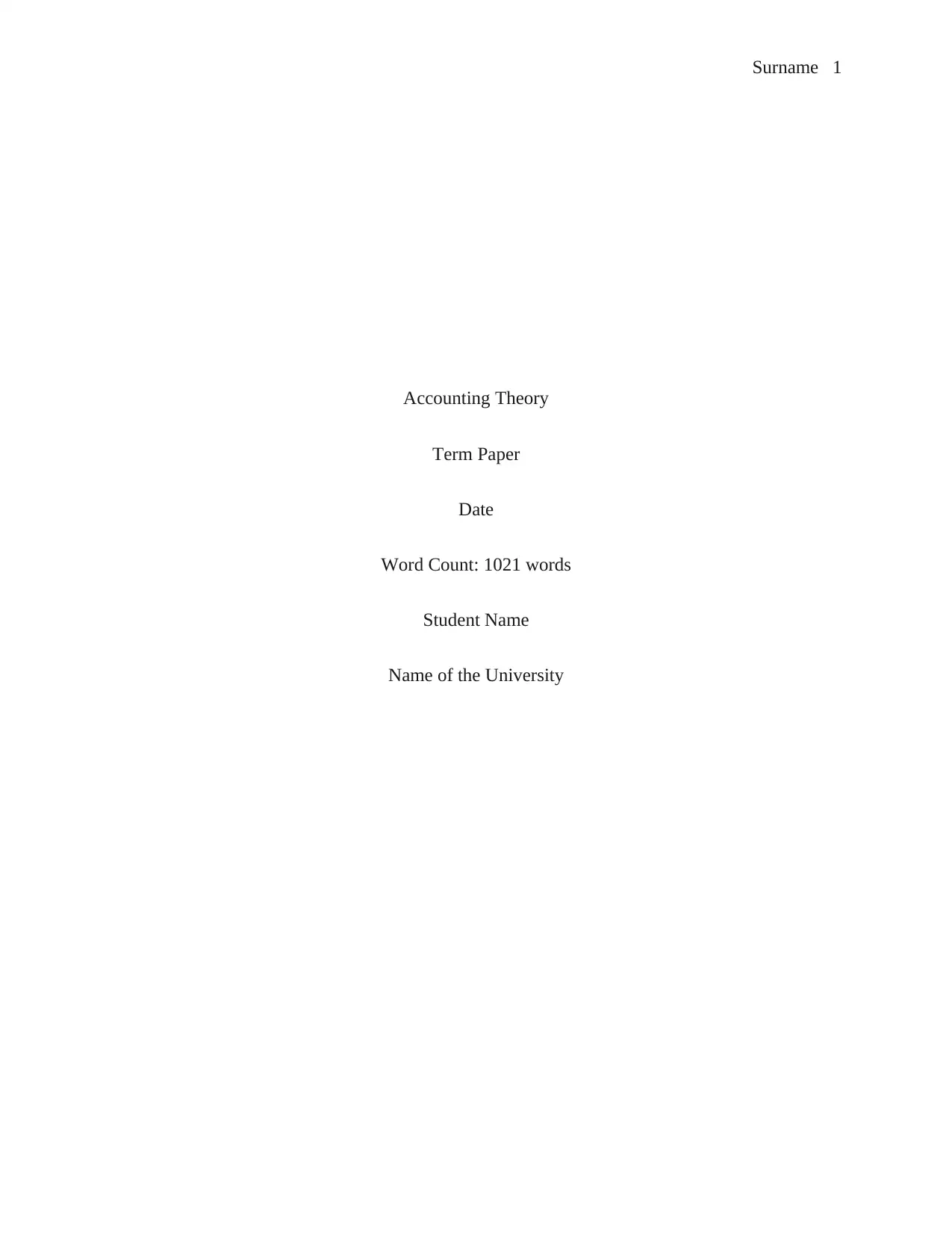
Surname 1
Accounting Theory
Term Paper
Date
Word Count: 1021 words
Student Name
Name of the University
Accounting Theory
Term Paper
Date
Word Count: 1021 words
Student Name
Name of the University
Paraphrase This Document
Need a fresh take? Get an instant paraphrase of this document with our AI Paraphraser
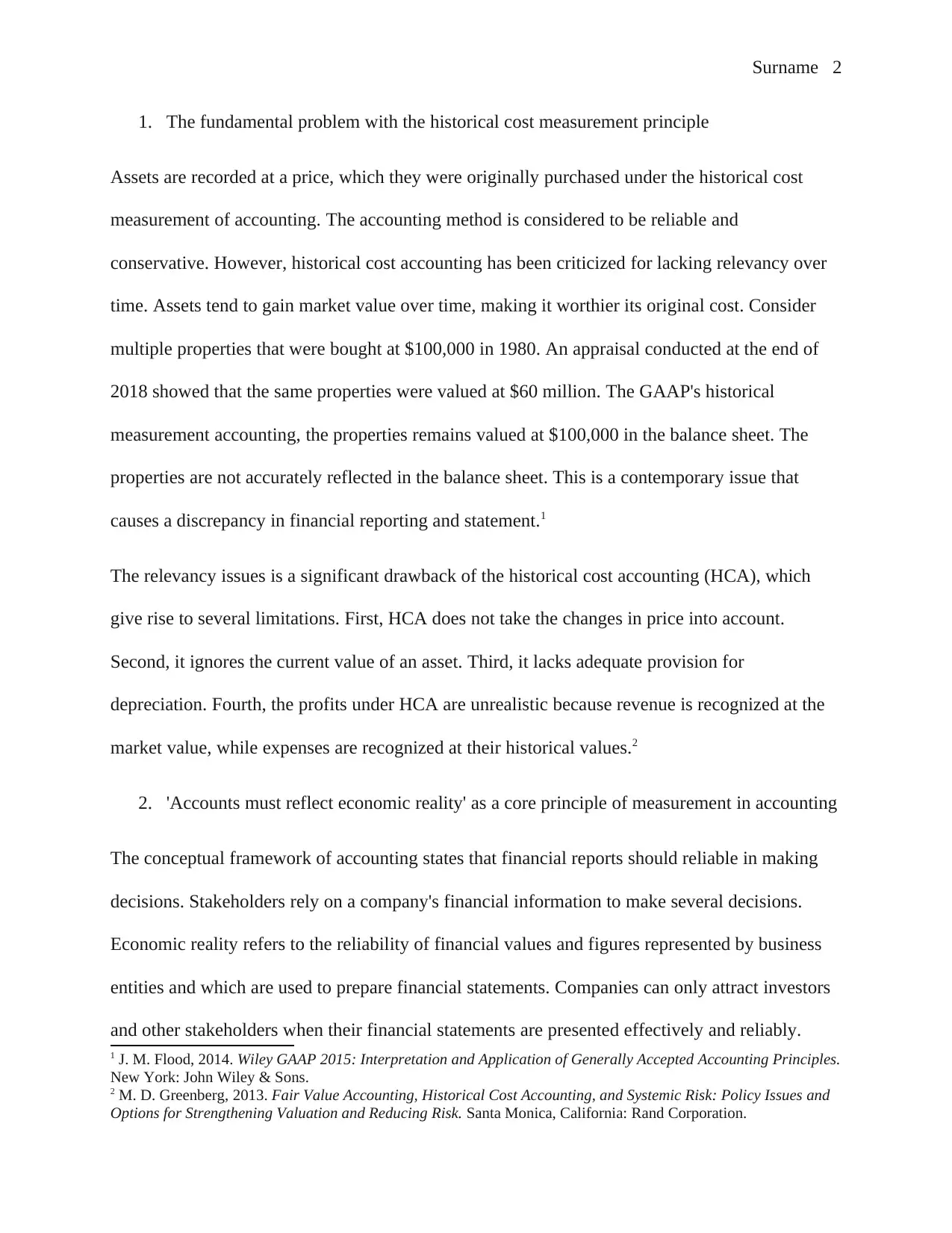
Surname 2
1. The fundamental problem with the historical cost measurement principle
Assets are recorded at a price, which they were originally purchased under the historical cost
measurement of accounting. The accounting method is considered to be reliable and
conservative. However, historical cost accounting has been criticized for lacking relevancy over
time. Assets tend to gain market value over time, making it worthier its original cost. Consider
multiple properties that were bought at $100,000 in 1980. An appraisal conducted at the end of
2018 showed that the same properties were valued at $60 million. The GAAP's historical
measurement accounting, the properties remains valued at $100,000 in the balance sheet. The
properties are not accurately reflected in the balance sheet. This is a contemporary issue that
causes a discrepancy in financial reporting and statement.1
The relevancy issues is a significant drawback of the historical cost accounting (HCA), which
give rise to several limitations. First, HCA does not take the changes in price into account.
Second, it ignores the current value of an asset. Third, it lacks adequate provision for
depreciation. Fourth, the profits under HCA are unrealistic because revenue is recognized at the
market value, while expenses are recognized at their historical values.2
2. 'Accounts must reflect economic reality' as a core principle of measurement in accounting
The conceptual framework of accounting states that financial reports should reliable in making
decisions. Stakeholders rely on a company's financial information to make several decisions.
Economic reality refers to the reliability of financial values and figures represented by business
entities and which are used to prepare financial statements. Companies can only attract investors
and other stakeholders when their financial statements are presented effectively and reliably.
1 J. M. Flood, 2014. Wiley GAAP 2015: Interpretation and Application of Generally Accepted Accounting Principles.
New York: John Wiley & Sons.
2 M. D. Greenberg, 2013. Fair Value Accounting, Historical Cost Accounting, and Systemic Risk: Policy Issues and
Options for Strengthening Valuation and Reducing Risk. Santa Monica, California: Rand Corporation.
1. The fundamental problem with the historical cost measurement principle
Assets are recorded at a price, which they were originally purchased under the historical cost
measurement of accounting. The accounting method is considered to be reliable and
conservative. However, historical cost accounting has been criticized for lacking relevancy over
time. Assets tend to gain market value over time, making it worthier its original cost. Consider
multiple properties that were bought at $100,000 in 1980. An appraisal conducted at the end of
2018 showed that the same properties were valued at $60 million. The GAAP's historical
measurement accounting, the properties remains valued at $100,000 in the balance sheet. The
properties are not accurately reflected in the balance sheet. This is a contemporary issue that
causes a discrepancy in financial reporting and statement.1
The relevancy issues is a significant drawback of the historical cost accounting (HCA), which
give rise to several limitations. First, HCA does not take the changes in price into account.
Second, it ignores the current value of an asset. Third, it lacks adequate provision for
depreciation. Fourth, the profits under HCA are unrealistic because revenue is recognized at the
market value, while expenses are recognized at their historical values.2
2. 'Accounts must reflect economic reality' as a core principle of measurement in accounting
The conceptual framework of accounting states that financial reports should reliable in making
decisions. Stakeholders rely on a company's financial information to make several decisions.
Economic reality refers to the reliability of financial values and figures represented by business
entities and which are used to prepare financial statements. Companies can only attract investors
and other stakeholders when their financial statements are presented effectively and reliably.
1 J. M. Flood, 2014. Wiley GAAP 2015: Interpretation and Application of Generally Accepted Accounting Principles.
New York: John Wiley & Sons.
2 M. D. Greenberg, 2013. Fair Value Accounting, Historical Cost Accounting, and Systemic Risk: Policy Issues and
Options for Strengthening Valuation and Reducing Risk. Santa Monica, California: Rand Corporation.
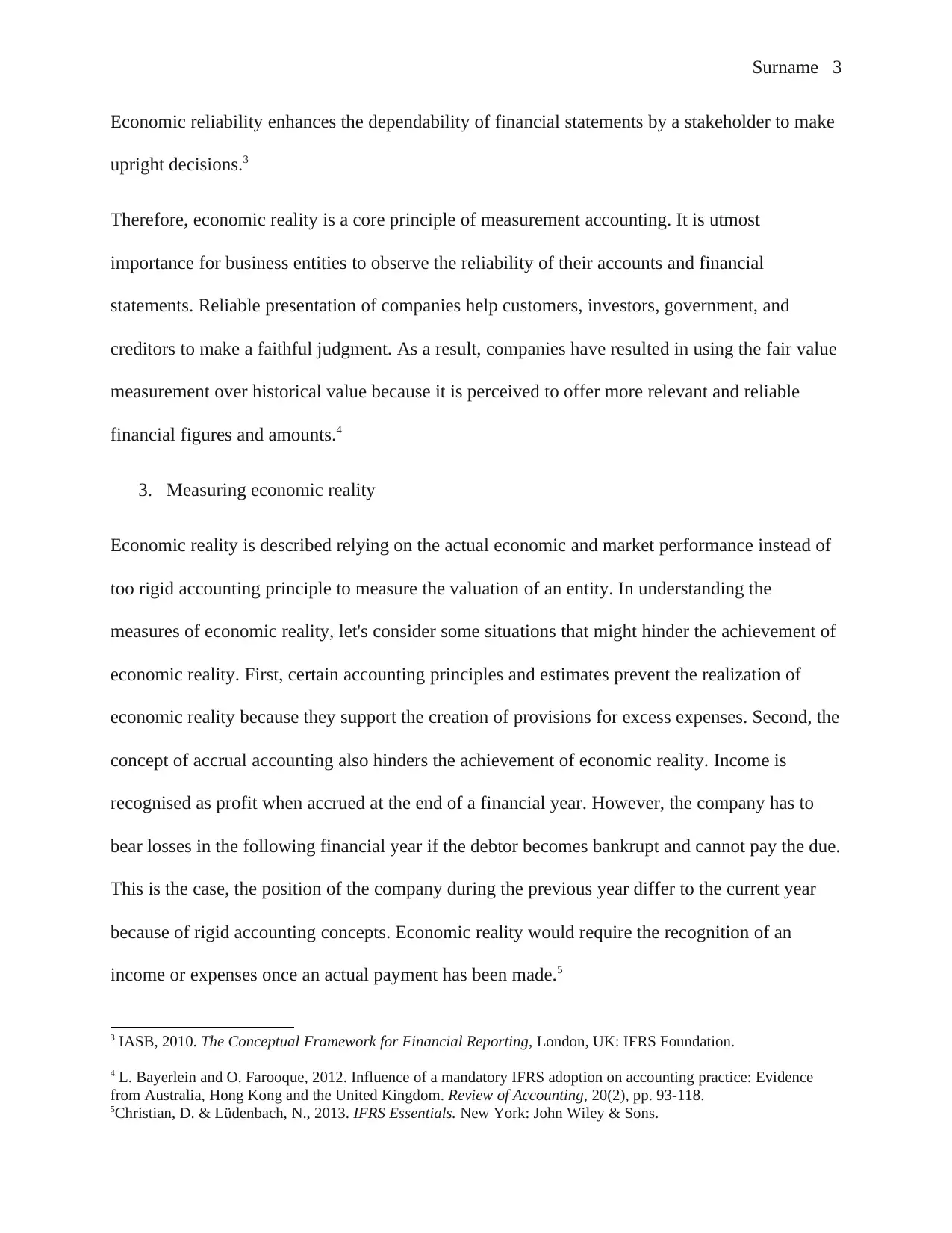
Surname 3
Economic reliability enhances the dependability of financial statements by a stakeholder to make
upright decisions.3
Therefore, economic reality is a core principle of measurement accounting. It is utmost
importance for business entities to observe the reliability of their accounts and financial
statements. Reliable presentation of companies help customers, investors, government, and
creditors to make a faithful judgment. As a result, companies have resulted in using the fair value
measurement over historical value because it is perceived to offer more relevant and reliable
financial figures and amounts.4
3. Measuring economic reality
Economic reality is described relying on the actual economic and market performance instead of
too rigid accounting principle to measure the valuation of an entity. In understanding the
measures of economic reality, let's consider some situations that might hinder the achievement of
economic reality. First, certain accounting principles and estimates prevent the realization of
economic reality because they support the creation of provisions for excess expenses. Second, the
concept of accrual accounting also hinders the achievement of economic reality. Income is
recognised as profit when accrued at the end of a financial year. However, the company has to
bear losses in the following financial year if the debtor becomes bankrupt and cannot pay the due.
This is the case, the position of the company during the previous year differ to the current year
because of rigid accounting concepts. Economic reality would require the recognition of an
income or expenses once an actual payment has been made.5
3 IASB, 2010. The Conceptual Framework for Financial Reporting, London, UK: IFRS Foundation.
4 L. Bayerlein and O. Farooque, 2012. Influence of a mandatory IFRS adoption on accounting practice: Evidence
from Australia, Hong Kong and the United Kingdom. Review of Accounting, 20(2), pp. 93-118.
5Christian, D. & Lüdenbach, N., 2013. IFRS Essentials. New York: John Wiley & Sons.
Economic reliability enhances the dependability of financial statements by a stakeholder to make
upright decisions.3
Therefore, economic reality is a core principle of measurement accounting. It is utmost
importance for business entities to observe the reliability of their accounts and financial
statements. Reliable presentation of companies help customers, investors, government, and
creditors to make a faithful judgment. As a result, companies have resulted in using the fair value
measurement over historical value because it is perceived to offer more relevant and reliable
financial figures and amounts.4
3. Measuring economic reality
Economic reality is described relying on the actual economic and market performance instead of
too rigid accounting principle to measure the valuation of an entity. In understanding the
measures of economic reality, let's consider some situations that might hinder the achievement of
economic reality. First, certain accounting principles and estimates prevent the realization of
economic reality because they support the creation of provisions for excess expenses. Second, the
concept of accrual accounting also hinders the achievement of economic reality. Income is
recognised as profit when accrued at the end of a financial year. However, the company has to
bear losses in the following financial year if the debtor becomes bankrupt and cannot pay the due.
This is the case, the position of the company during the previous year differ to the current year
because of rigid accounting concepts. Economic reality would require the recognition of an
income or expenses once an actual payment has been made.5
3 IASB, 2010. The Conceptual Framework for Financial Reporting, London, UK: IFRS Foundation.
4 L. Bayerlein and O. Farooque, 2012. Influence of a mandatory IFRS adoption on accounting practice: Evidence
from Australia, Hong Kong and the United Kingdom. Review of Accounting, 20(2), pp. 93-118.
5Christian, D. & Lüdenbach, N., 2013. IFRS Essentials. New York: John Wiley & Sons.
⊘ This is a preview!⊘
Do you want full access?
Subscribe today to unlock all pages.

Trusted by 1+ million students worldwide
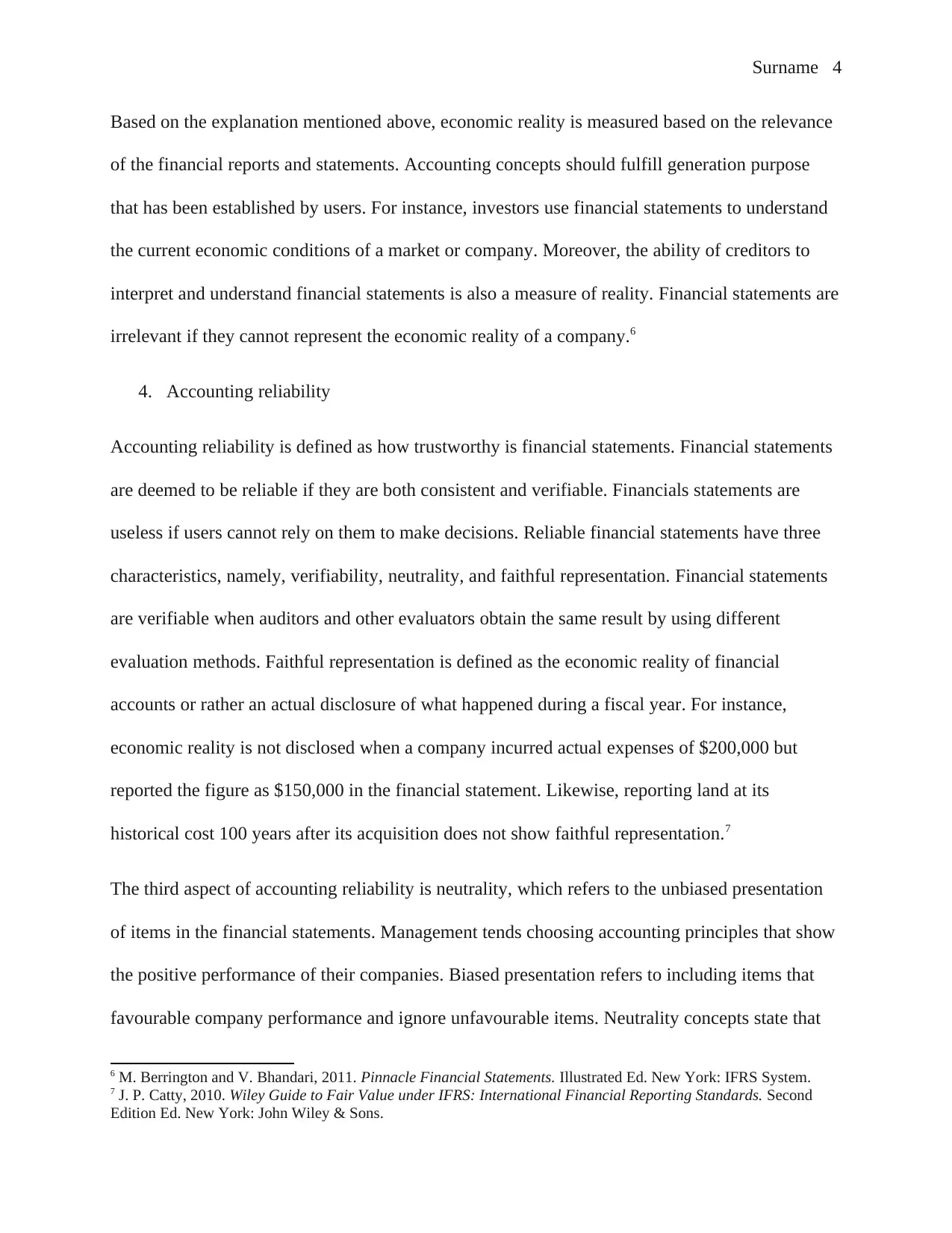
Surname 4
Based on the explanation mentioned above, economic reality is measured based on the relevance
of the financial reports and statements. Accounting concepts should fulfill generation purpose
that has been established by users. For instance, investors use financial statements to understand
the current economic conditions of a market or company. Moreover, the ability of creditors to
interpret and understand financial statements is also a measure of reality. Financial statements are
irrelevant if they cannot represent the economic reality of a company.6
4. Accounting reliability
Accounting reliability is defined as how trustworthy is financial statements. Financial statements
are deemed to be reliable if they are both consistent and verifiable. Financials statements are
useless if users cannot rely on them to make decisions. Reliable financial statements have three
characteristics, namely, verifiability, neutrality, and faithful representation. Financial statements
are verifiable when auditors and other evaluators obtain the same result by using different
evaluation methods. Faithful representation is defined as the economic reality of financial
accounts or rather an actual disclosure of what happened during a fiscal year. For instance,
economic reality is not disclosed when a company incurred actual expenses of $200,000 but
reported the figure as $150,000 in the financial statement. Likewise, reporting land at its
historical cost 100 years after its acquisition does not show faithful representation.7
The third aspect of accounting reliability is neutrality, which refers to the unbiased presentation
of items in the financial statements. Management tends choosing accounting principles that show
the positive performance of their companies. Biased presentation refers to including items that
favourable company performance and ignore unfavourable items. Neutrality concepts state that
6 M. Berrington and V. Bhandari, 2011. Pinnacle Financial Statements. Illustrated Ed. New York: IFRS System.
7 J. P. Catty, 2010. Wiley Guide to Fair Value under IFRS: International Financial Reporting Standards. Second
Edition Ed. New York: John Wiley & Sons.
Based on the explanation mentioned above, economic reality is measured based on the relevance
of the financial reports and statements. Accounting concepts should fulfill generation purpose
that has been established by users. For instance, investors use financial statements to understand
the current economic conditions of a market or company. Moreover, the ability of creditors to
interpret and understand financial statements is also a measure of reality. Financial statements are
irrelevant if they cannot represent the economic reality of a company.6
4. Accounting reliability
Accounting reliability is defined as how trustworthy is financial statements. Financial statements
are deemed to be reliable if they are both consistent and verifiable. Financials statements are
useless if users cannot rely on them to make decisions. Reliable financial statements have three
characteristics, namely, verifiability, neutrality, and faithful representation. Financial statements
are verifiable when auditors and other evaluators obtain the same result by using different
evaluation methods. Faithful representation is defined as the economic reality of financial
accounts or rather an actual disclosure of what happened during a fiscal year. For instance,
economic reality is not disclosed when a company incurred actual expenses of $200,000 but
reported the figure as $150,000 in the financial statement. Likewise, reporting land at its
historical cost 100 years after its acquisition does not show faithful representation.7
The third aspect of accounting reliability is neutrality, which refers to the unbiased presentation
of items in the financial statements. Management tends choosing accounting principles that show
the positive performance of their companies. Biased presentation refers to including items that
favourable company performance and ignore unfavourable items. Neutrality concepts state that
6 M. Berrington and V. Bhandari, 2011. Pinnacle Financial Statements. Illustrated Ed. New York: IFRS System.
7 J. P. Catty, 2010. Wiley Guide to Fair Value under IFRS: International Financial Reporting Standards. Second
Edition Ed. New York: John Wiley & Sons.
Paraphrase This Document
Need a fresh take? Get an instant paraphrase of this document with our AI Paraphraser
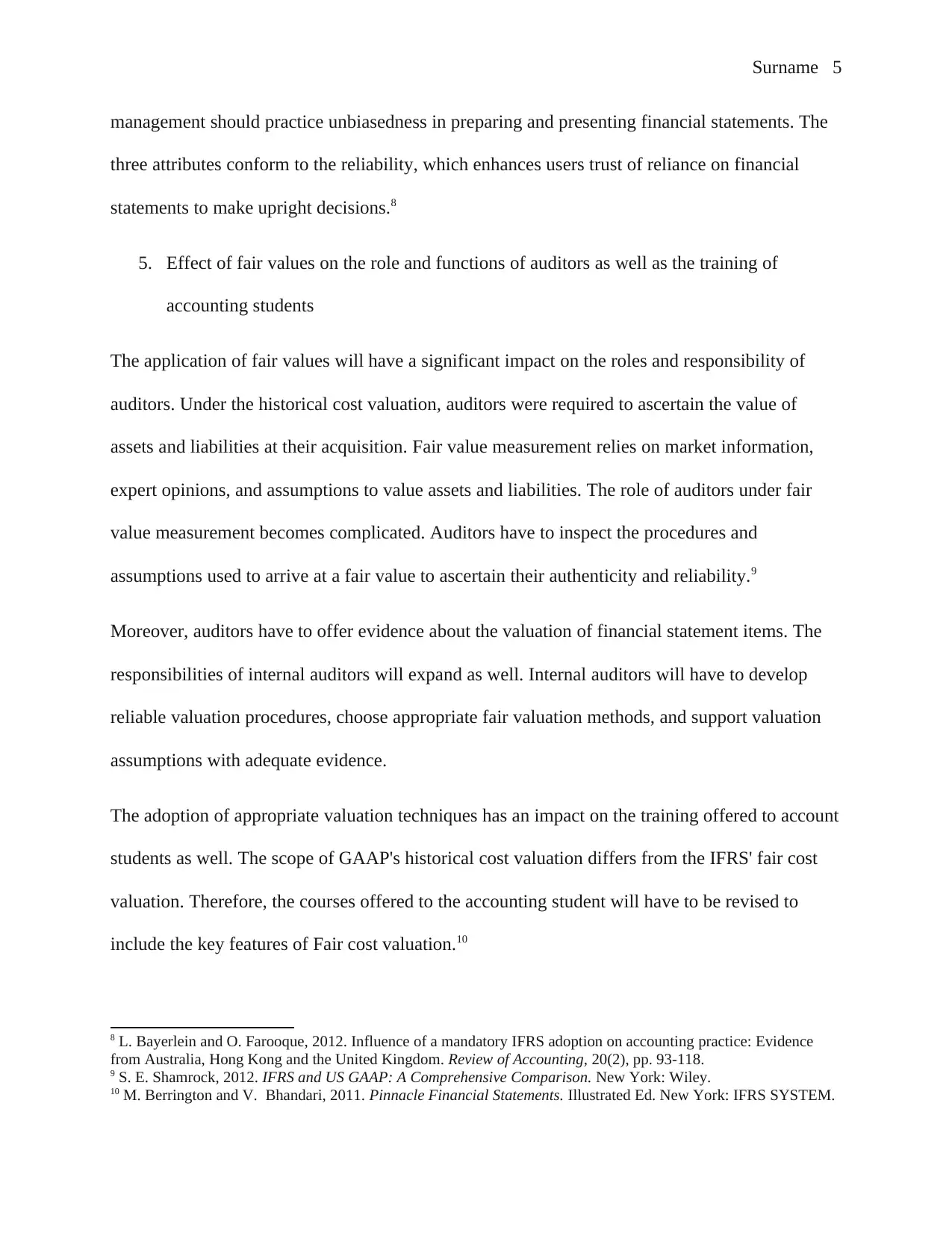
Surname 5
management should practice unbiasedness in preparing and presenting financial statements. The
three attributes conform to the reliability, which enhances users trust of reliance on financial
statements to make upright decisions.8
5. Effect of fair values on the role and functions of auditors as well as the training of
accounting students
The application of fair values will have a significant impact on the roles and responsibility of
auditors. Under the historical cost valuation, auditors were required to ascertain the value of
assets and liabilities at their acquisition. Fair value measurement relies on market information,
expert opinions, and assumptions to value assets and liabilities. The role of auditors under fair
value measurement becomes complicated. Auditors have to inspect the procedures and
assumptions used to arrive at a fair value to ascertain their authenticity and reliability.9
Moreover, auditors have to offer evidence about the valuation of financial statement items. The
responsibilities of internal auditors will expand as well. Internal auditors will have to develop
reliable valuation procedures, choose appropriate fair valuation methods, and support valuation
assumptions with adequate evidence.
The adoption of appropriate valuation techniques has an impact on the training offered to account
students as well. The scope of GAAP's historical cost valuation differs from the IFRS' fair cost
valuation. Therefore, the courses offered to the accounting student will have to be revised to
include the key features of Fair cost valuation.10
8 L. Bayerlein and O. Farooque, 2012. Influence of a mandatory IFRS adoption on accounting practice: Evidence
from Australia, Hong Kong and the United Kingdom. Review of Accounting, 20(2), pp. 93-118.
9 S. E. Shamrock, 2012. IFRS and US GAAP: A Comprehensive Comparison. New York: Wiley.
10 M. Berrington and V. Bhandari, 2011. Pinnacle Financial Statements. Illustrated Ed. New York: IFRS SYSTEM.
management should practice unbiasedness in preparing and presenting financial statements. The
three attributes conform to the reliability, which enhances users trust of reliance on financial
statements to make upright decisions.8
5. Effect of fair values on the role and functions of auditors as well as the training of
accounting students
The application of fair values will have a significant impact on the roles and responsibility of
auditors. Under the historical cost valuation, auditors were required to ascertain the value of
assets and liabilities at their acquisition. Fair value measurement relies on market information,
expert opinions, and assumptions to value assets and liabilities. The role of auditors under fair
value measurement becomes complicated. Auditors have to inspect the procedures and
assumptions used to arrive at a fair value to ascertain their authenticity and reliability.9
Moreover, auditors have to offer evidence about the valuation of financial statement items. The
responsibilities of internal auditors will expand as well. Internal auditors will have to develop
reliable valuation procedures, choose appropriate fair valuation methods, and support valuation
assumptions with adequate evidence.
The adoption of appropriate valuation techniques has an impact on the training offered to account
students as well. The scope of GAAP's historical cost valuation differs from the IFRS' fair cost
valuation. Therefore, the courses offered to the accounting student will have to be revised to
include the key features of Fair cost valuation.10
8 L. Bayerlein and O. Farooque, 2012. Influence of a mandatory IFRS adoption on accounting practice: Evidence
from Australia, Hong Kong and the United Kingdom. Review of Accounting, 20(2), pp. 93-118.
9 S. E. Shamrock, 2012. IFRS and US GAAP: A Comprehensive Comparison. New York: Wiley.
10 M. Berrington and V. Bhandari, 2011. Pinnacle Financial Statements. Illustrated Ed. New York: IFRS SYSTEM.
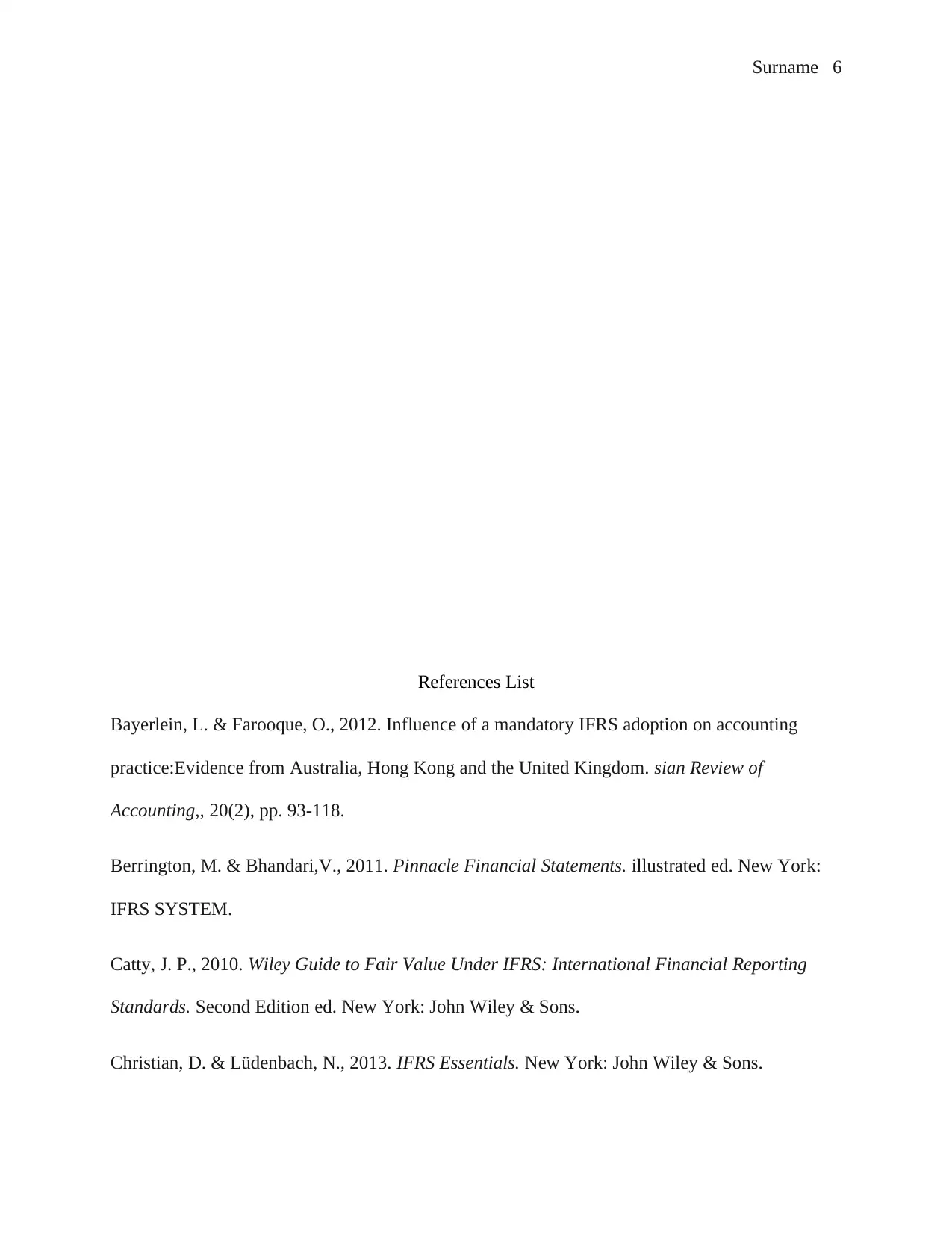
Surname 6
References List
Bayerlein, L. & Farooque, O., 2012. Influence of a mandatory IFRS adoption on accounting
practice:Evidence from Australia, Hong Kong and the United Kingdom. sian Review of
Accounting,, 20(2), pp. 93-118.
Berrington, M. & Bhandari,V., 2011. Pinnacle Financial Statements. illustrated ed. New York:
IFRS SYSTEM.
Catty, J. P., 2010. Wiley Guide to Fair Value Under IFRS: International Financial Reporting
Standards. Second Edition ed. New York: John Wiley & Sons.
Christian, D. & Lüdenbach, N., 2013. IFRS Essentials. New York: John Wiley & Sons.
References List
Bayerlein, L. & Farooque, O., 2012. Influence of a mandatory IFRS adoption on accounting
practice:Evidence from Australia, Hong Kong and the United Kingdom. sian Review of
Accounting,, 20(2), pp. 93-118.
Berrington, M. & Bhandari,V., 2011. Pinnacle Financial Statements. illustrated ed. New York:
IFRS SYSTEM.
Catty, J. P., 2010. Wiley Guide to Fair Value Under IFRS: International Financial Reporting
Standards. Second Edition ed. New York: John Wiley & Sons.
Christian, D. & Lüdenbach, N., 2013. IFRS Essentials. New York: John Wiley & Sons.
⊘ This is a preview!⊘
Do you want full access?
Subscribe today to unlock all pages.

Trusted by 1+ million students worldwide
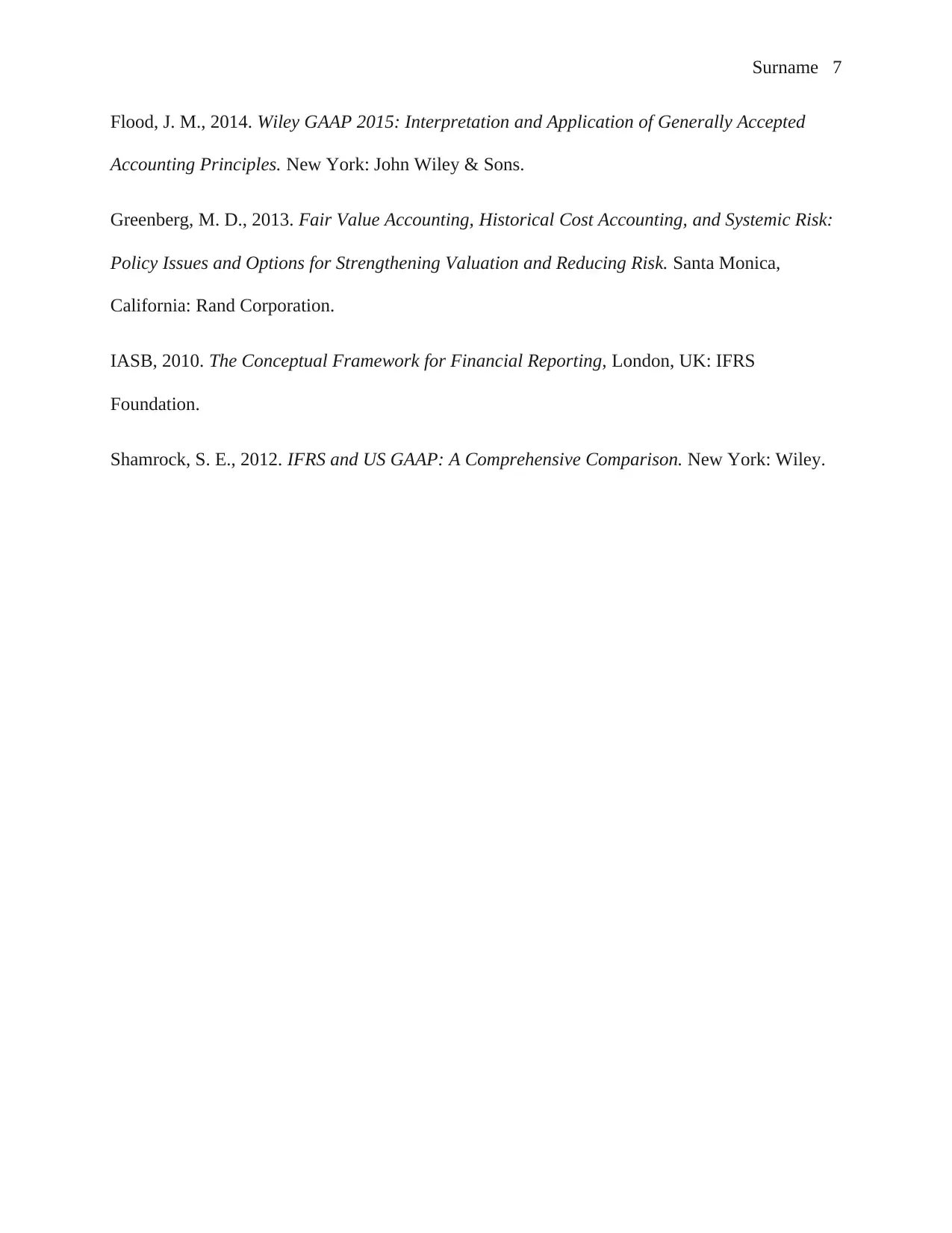
Surname 7
Flood, J. M., 2014. Wiley GAAP 2015: Interpretation and Application of Generally Accepted
Accounting Principles. New York: John Wiley & Sons.
Greenberg, M. D., 2013. Fair Value Accounting, Historical Cost Accounting, and Systemic Risk:
Policy Issues and Options for Strengthening Valuation and Reducing Risk. Santa Monica,
California: Rand Corporation.
IASB, 2010. The Conceptual Framework for Financial Reporting, London, UK: IFRS
Foundation.
Shamrock, S. E., 2012. IFRS and US GAAP: A Comprehensive Comparison. New York: Wiley.
Flood, J. M., 2014. Wiley GAAP 2015: Interpretation and Application of Generally Accepted
Accounting Principles. New York: John Wiley & Sons.
Greenberg, M. D., 2013. Fair Value Accounting, Historical Cost Accounting, and Systemic Risk:
Policy Issues and Options for Strengthening Valuation and Reducing Risk. Santa Monica,
California: Rand Corporation.
IASB, 2010. The Conceptual Framework for Financial Reporting, London, UK: IFRS
Foundation.
Shamrock, S. E., 2012. IFRS and US GAAP: A Comprehensive Comparison. New York: Wiley.
1 out of 7
Related Documents
Your All-in-One AI-Powered Toolkit for Academic Success.
+13062052269
info@desklib.com
Available 24*7 on WhatsApp / Email
![[object Object]](/_next/static/media/star-bottom.7253800d.svg)
Unlock your academic potential
Copyright © 2020–2025 A2Z Services. All Rights Reserved. Developed and managed by ZUCOL.





